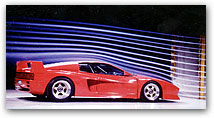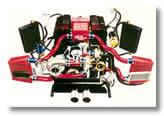8. Koenigsegg CCX £415000




Koenigsegg's new CCR takes over as the company's fastest ever (and one of the world's fastest ever) supercars. Retaining the mighty 806 bhp supercharged V8 from the CCR, the Competition Coupe X has been fettled to produce even faster performance, namely 0-60mph in a shade over 3sec and a pulverising 245mph top speed (second only to the Veyron). Pace is unquestionable but handling is demanding (the rear spoiler is not just there for aesthetics, just ask the Stig)!
What must be the loudest car on the planet is yours for £415,000 but be quick, they only build 12 a year. And if 806 bhp is not enough then just fill it up with super unleaded, it's worth another 40 bhp!


 Performance
Performance Acceleration: 0-100 km/h (0-62 mph) 3.2 seconds
0-200 km/h 9.8 sec, 0-200-0 km/h 14 sec
Top Speed: 395+ km/h (245+ mph)
Braking distance: 32m (100-0 km/h)
Lateral G-force: 1.3 G
Fuel consumption: Highway travel: 13 l/100km, Combined: 17 l/100km
Weight-to-power ratio: 1.59 kg/hp
Weight distribution: 45% front, 55% rear
Aerodynamics Cd. 0,32 Frontal area 1.867 m2
Total Downforce at 250 km/h: 100 kg
Flat underside of chassis. Venturi tunnels at rear of chassis/body
ChassisCarbon fibre with aluminium honeycomb and integrated fuel tanks for optimal weight distribution and safety. Monocoque torsional rigidity: 58,000 nm/degree. Weight including tanks: 72 kg.
Front and rear suspension: Double wishbones, two-way adjustable VPS gas-hydraulic shock absorbers, pushrod operated. Electronically adjustable ride height.
Front: Cro-Mo subframe, with integrated crash members.
Rear: Semi-stressed engine and gearbox with support struts, for optimal rigidity and no engine inertia movements.
Fully machined aircraft aluminium uprights, with SKF LeMans specification 150mm angle contact ball bearings.
GKN hollow/gun-drilled driveshafts.
Koenigsegg Z-style progressive and lightweight anti-roll bars front and rear.
EngineKoenigsegg aluminium V8, 4 valves per cylinder, double overhead camshafts
Displacement: 4700 cc
Compression: 8.2:1
Sequential multipoint fuel injection
Twin Rotrex centrifugal superchargers with response system, 1.4 bar boost pressure
Dry sump lubrication with oil spray piston cooling
Power output: 806 Bhp at 7000 rpm
Maximum torque: 920 Nm (693 ft/lb) at 5500 rpm
Carbon fibre intake manifold with optimised intake tracts
Patented response charge system for optimal engine response
Tig-welded ceramic-coated stainless steel exhaust manifold with merge collector
Emission levels: Euro IV and US
Weight 178 kg
TransmissionSpecially developed transversal 6-speed gearbox, with optional paddle-shift
Torque sensitive limited slip differential.
Clutch: Dual Plate, Ø 240 mm (in paddle-shift version without clutch pedal)
Final ratio: 3,364
1st gear: 2,875
2nd gear: 1,773
3rd gear: 1,267
4th gear: 1,000
5th gear: 0,833
6th gear: 0,711
Reverse gear: 3,000
SteeringRack and pinion power-assisted steering. 2.7 turns lock-to-lock.
Turning circle: 11 metres. TRW electro-hydraulic power-assisted.
BrakesFront brakes: Ventilated ceramic discs Ø 380 mm, 34 mm wide. 8-piston light alloy Brembo monoblock calipers. Power-assisted.
Rear brakes: Ventilated ceramic discs Ø 362 mm, 32 mm wide. 6-piston light alloy AP Racing callipers. Power-assisted.
Traction Control F1-style for optimal performance with 5 different handling modes. Power output: 1018 Bhp at 7000 rpm (E85 fuel)
Maximum torque: 1060 Nm (740 ft/lb) at 5600 rpm (E85 fuel)
Wheels Koenigsegg carbon alloy wheels with centre locking
Front: 19” x 9.5”
Rear: 20” x 12.5”
Tyres Michelin Pilot Sport 2
Unidirectional with asymmetric tread pattern
Front: 255/35 - 19” (Y)
Rear: 335/30 - 20” (Y)
BodyTwo-door, two seater with removable hardtop stowable under the front hood lid. Body made from pre-impregnated carbon fibre/kevlar and lightweight sandwich reinforcements.
Electrical SystemSolid state digital semiconductors - no fuses or relays. Canbus operated and fully programmable functionality.
EquipmentDual Airbags, detachable storable hardtop with glass roof, power windows, rear wing, adjustable pedals and steering column, adjustable seats in rake and length, carbon ceramic brakes with ABS, hydraulic lifting system, power steering, power brakes, satnav, rear camera, DVD, CD, I-pod connection, sat radio, climate control, digital warning and info system, G sensor, alarm, tyre monitoring system, silver key, leather carpets, roof stowage bag, car cover.
Extra EquipmentPaddle-shift, Chrono instrument cluster, carbon wheels, forged aluminium wheels, fitted luggage, special leather and colour requests, Inconell exhaust system.
Dimensions Total length: 4293 mm (169”)
Total width: 1996 mm (78.6”)
Total height: 1120 mm (44.1”)
Ground clearance: Rear: 100 mm (3.94”) Front: 100 mm (3.94”)
Fuel capacity: 70 litres (18.5 US gallons)
Luggage compartment: 120 litres (31.7 US gallons)
Dry weight: 1280 kg (2821 lbs)
2 Years’ Warranty.
All information correct at time of publication, and subject to change.
http://www.koenigsegg.se






























































